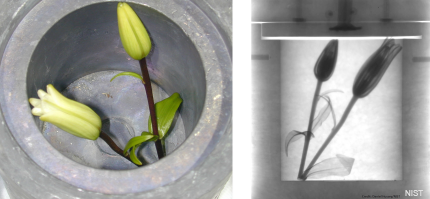Machine would see inside where X-rays cannot
Military researchers want to combine X-ray and neutron radiography in a device small enough for field use.

A neutron imaging system shows a detailed image of lilies (at right) taken through the side of a lead cask in this example by the National Institute of standards and Technology.
Military researchers are looking to go one up on Superman, developing a machine capable of detecting elements that X-rays cannot, and be able to do it through dense materials such as lead.
The Defense Advanced Research Projects Agency has released a solicitation looking for innovative ideas on building a portable device that combines X-ray and neutron radiography.
“Portable” in this sense is a relative term, since the device DARPA wants to build would be about a meter (3.3 feet) long. But that would represent a big reduction in the size, weight and power requirements of current neutron radiography units, which can be 10 meters or more long, DARPA said in a release.
The agency’s Intense and Compact Neutron Sources (ICONS) program aims to to develop a combines X-ray/neutron device for such uses as assessing the health of aircrafts and other military equipment, detecting explosives or contraband, and in forensics.
X-ray machines, best known for their medical and passenger-screening uses, have also proven valuable for such tasks as detecting cracks in an airplane’s wing. But the technology does have its limits. As DARPA explains it, X-ray imagery’s strength is in detecting heavy elements, but not lighter ones. Its inability to detect hydrogen, for example, makes it useless in water or other liquids.
Neutron radiography, as its name suggests, makes use of neutrons to create images and can get clear images of lighter elements and liquids—sometimes clear enough to identify a substance’s atomic makeup, DARPA said. And neutron can pass through lead and other heavy materials.
Combining the two in a relatively tiny package—about the size of current portable x-ray tubes—could bring advanced radiography to the field. The real trick will be getting the size of the machine down to a manageable size.
“We’re looking for innovative designs and construction methods to shrink a neutron accelerator from 10 meters or longer down to 1 meter or less, similar to the size of portable X-ray tubes today,” Vincent Tang, DARPA program manager, said in the release. “Creating a high-yield, directional neutron source in a very compact package is a significant challenge. But a successful ICONS program would provide an imaging tool with significant national security applications, able to deliver very detailed, accurate internal imaging of objects in any setting.”



